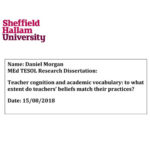Teaching Grammar in Second Language Classrooms: Integrating Form-Focused Instruction in Communicative Context.
Hossein Nassaji and Sandra Fotos. New York. Routledge, 2011. Pp. ix+167.
Reviewed by Karim Sadeghi, Urmia University, Urmia, Iran,
Mohammad Jokar, Shiraz University, Shiraz, Iran,
Ali Soyoof, Islamic Azad University, Shiraz branch, Iran
Teaching Grammar in Second Language Classrooms by Hossein Nassaji and Sandra Fotos brings to the reader some insights in both theory and research on communicative grammar instruction. The authors offer instructional choices for teachers to better the quality of learning. They also focus on the integration of grammar and communication in language classrooms. The authors wish to help teachers, teacher trainers, and SLA researchers to foster their understanding of how to find an interface between grammar and meaning.
The book consists of nine substantial chapters. Chapter 1 presents an overview of the changes in grammar instruction over the years. Ascribing the wax and wane of different grammar teaching approaches to a set of theoretical and empirical developments in the field, the authors divide the journey of grammar teaching into three phases, from a phase “in which grammar instruction was central, to one in which grammar instruction was absent, and to the recent reconsideration of the significance of the role of grammar instruction” (p. i).
In chapters 2, 3, 4 input-based options in focus on grammar, namely, processing instruction (PI), textual enhancement, and discourse are discussed. It is suggested that these options direct learners’ attention to grammar while meaning is at the center of attention. In PI, explicit instruction is followed by some input-processing activities. This way, learners can create form-meaning association. The authors argue that PI may be more effective for promoting receptive skills. Nassaji and Fotos suggest that effective grammar teaching should provide copious opportunities for both input and output; that is, PI should not be used as the only tool for language practice.
Chapter 3 presents another input-based approach to grammar teaching, namely, textual enhancement. Textually enhanced input is a kind of input that is made more noticeable to learners by highlighting some of its parts. The authors start chapter 3 by discussing theoretical underpinnings of textual enhancement. A portion of this chapter is devoted to reviewing the empirical research examining its effectiveness. Nassaji and Fotos conclude that textual enhancement leads to better learning outcomes provided that it is used in conjunction with various forms of input, output-based practices
Chapter 4 discusses discourse as a tool to teach grammar communicatively. The authors are mostly concerned with providing some guidelines on how grammar teaching should be approached using discourse. It is suggested that the provision of discourse-level input and form-focused discourse-level output contributes to increasing awareness of grammatical structures amongst learners and hence, leads to better learning outcomes.
The three subsequent chapters (5, 6, 7) consider the impact of output on grammar and its implications. Chapter 5 mainly draws readers’ attention to form through interactional feedback. The authors argue that L2 instruction should provide ample opportunities for meaningful interaction as well as opportunities for giving feedback on learners’ output. They cast light on how a focus on grammar can be attained through involvement in meaningful interaction with teachers and other learners. Through-out this chapter, they argue that interactional feedback can be considered a good benchmark for correcting students’ errors while not being deemed as the only method to direct learners’ attention to grammar.
Chapter 6 addresses how communicative task is designed and how it can call learners’ attention to certain grammatical forms. Moreover, it discusses various grammar-focused tasks. It also displays how ample opportunities can be provided to increase learner participation by performing such tasks in the classroom. It is argued that a major goal of grammar focused-task is to draw learners’ attention to form. It also aims to enhance language form by giving learners “grammar problems to solve interactively” (p.100).
Chapter 7 concentrates on how collaborative activities and participation of learners in these activities can enhance learners’ focus on grammar. The authors argue that collaborative output tasks such as output jigsaw and dictogloss enable learners to produce output and various scaffolding feedback options. This way, learners’ negotiation and grammatical skills are augmented.
Chapter 8 discusses the role of context in communicative focus on grammar. This chapter enumerates contextual factors which have important implications for teaching grammar. Considering the peculiarities of EFL and ESL contexts, Nassaji and Fotos emphasize that each context necessitates particular techniques for focusing on grammar. They suggest that activities used in each context be in line with the goals of each context.
The final chapter, chapter 9, provides a summary of the aforementioned chapters. The authors provide a set of additional comments which can be effective for teaching and incorporating grammar into L2 classroom. They believe that experience can be deemed as a panacea for the potential gap between theory and practice.
There are several criteria by which to judge the success of such a book. The book is clearly written, well-organized, and follows a progression from theory and research to practice. In every chapter of this book, the authors’ breadth of knowledge of Form-focused Instruction and grammar teaching is evident. This book has a lot of interesting things to say regarding how to integrate form-focused instruction in communicative contexts. However, the authors, in chapter 8, seem to have forgotten to refer to studies such as Auerbach (1993), which question L1 use in L2 classrooms. Emphasizing the use of L1 in EFL language classrooms, Nassaji and Fotos fall short of accounting for a less rigid and more balanced view of the use of L1 (Atkinson, 1987; Carless, 2008). Moreover, it seems that whenever Nassaji and Fotos try to make an assertion about different aspects of communicative grammar teaching, they mainly tend to use their own research to support their arguments. In other words, the book is a showcase of research studies done by these two scholars, an indication of their mastery over the field. However, the authors could have used research findings other than their own to support their viewpoints.
References
Atkinson, D. (1987). The mother tongue in the classroom: A neglected resource? ELT Journal, 41, 241-247.
Auerbach, E. (1993). Reexamining English only in the ESL classroom. TESOL Quarterly, 27, 9-32.
Carless, D. (2008). Student use of the mother tongue in the task-based classroom. ELT Journal, 62(4), 331-338.
Karim Sadeghi has a PhD in TEFL/TESOL (Language Testing) from the University of East Anglia in Norwich, UK. His main research interests include: language testing, alternative assessment, reading comprehension and error analysis. He was selected as the Best Researcher of Urmia University in 2007, and as the Top Researcher of Iran in 2013. He is currently the editor-in-chief of Iranian Journal of Language Teaching Research.
Mohammad Jokar is currently an M.A student at Shiraz University. Ranked 11 in Iran’s national University Entrance Exam, he entered Shiraz University, a well-reputed university in Iran, to get his Masters degree. He has presented several papers in many national and international conferences in Iran and abroad.
Ali Soyoof is an M.A student at Islamic Azad University, Shiraz branch. His main area of Interest is E-LEARNING, especially Videogames and CALL. He has some inter/national conferences and papers in both Iran and aboard.








